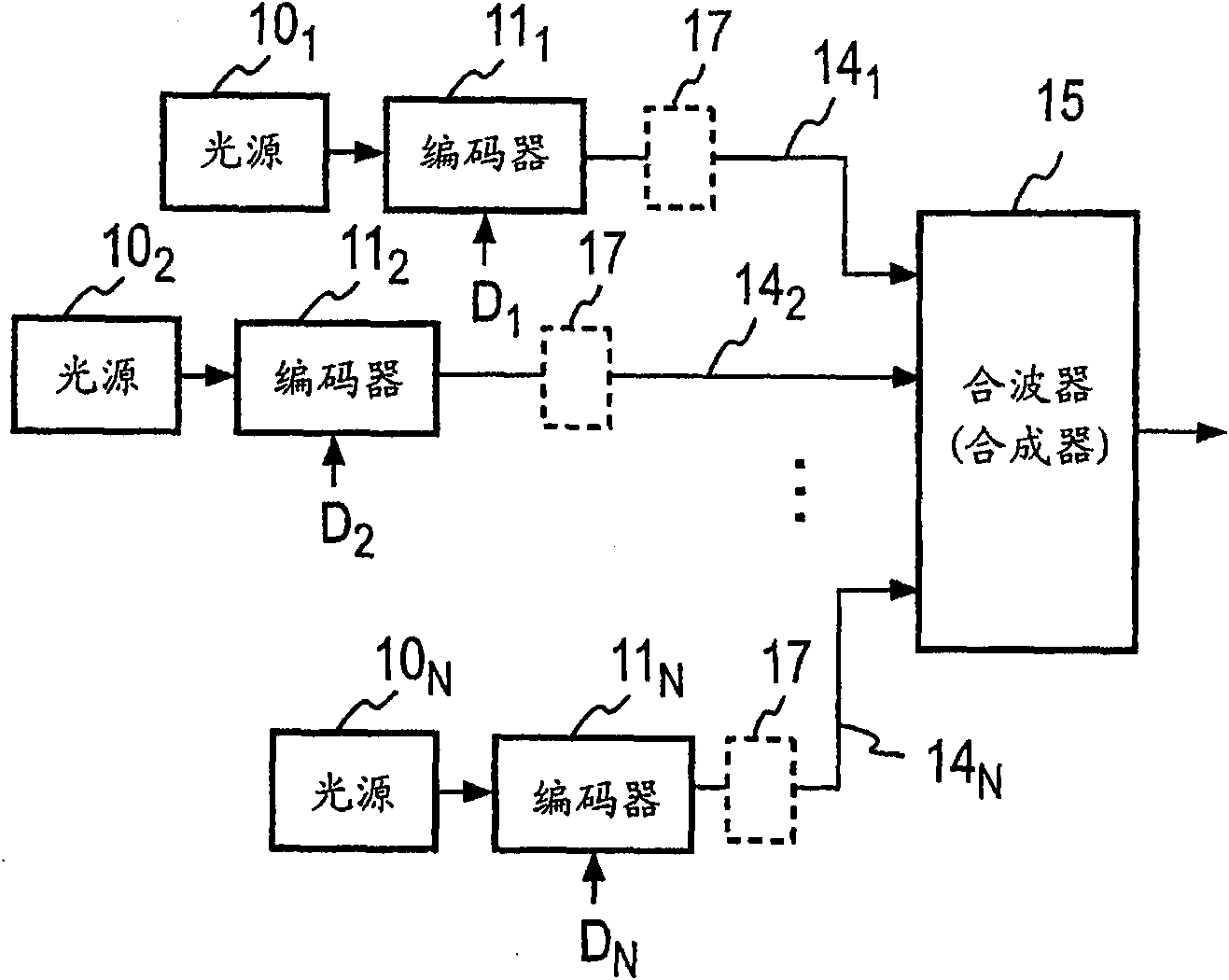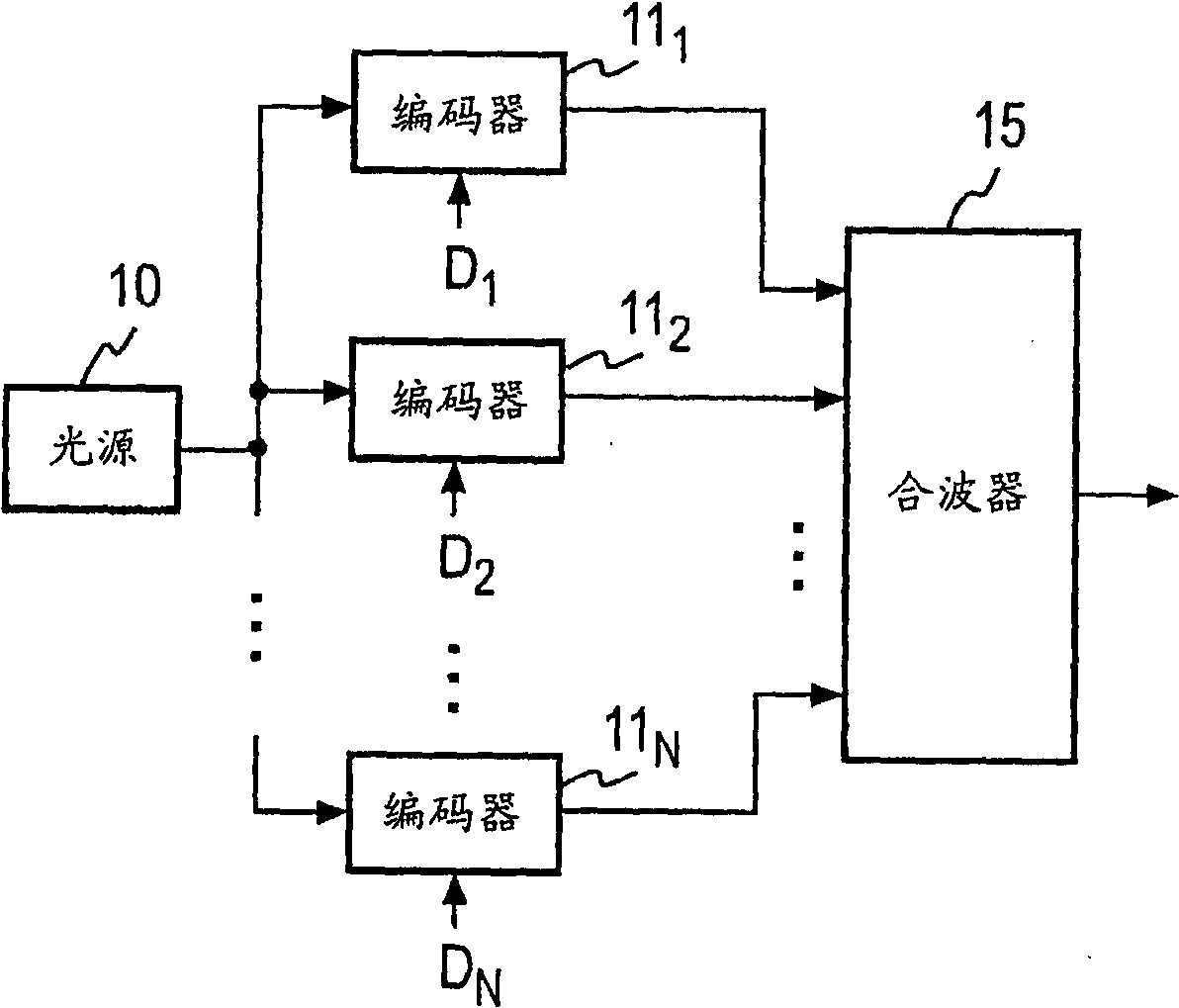Optical communication system using optical frequency code, optical transmission device and optical reception device thereof, and reflection type optical communication device
An optical communication system and optical frequency technology, which is applied in the field of optical communication systems, can solve problems such as deterioration of communication quality and poor extinction ratio of downlink optical signals, and achieve the effect of rough control accuracy and easy realization
- Summary
- Abstract
- Description
- Claims
- Application Information
AI Technical Summary
Problems solved by technology
Method used
Image
Examples
Embodiment 1-1
[0120] Figure 4 It represents Embodiment 1-1 of applying the principle of the first working mode of the present invention to a single-channel communication system. This embodiment 1-1 is the same as the existing optical communication system, has a light source 10, an encoder 11, a decoder 12, an optical transmission path (optical fiber) 13, and furthermore, includes a dispersion compensator 17 in this embodiment 1-1, Since the frequency-dependent propagation delay time differs due to the frequency dispersion of the optical transmission path, average compensation is performed so that the delay time between transmission and reception of each frequency component constituting the optical coded signal is the same. The optical frequency region to be compensated by the dispersion compensator 17 is at least wider than the optical frequency region used as the optical code signal.
[0121] The light source 10 outputs at least an optical signal of an optical bandwidth FSR corresponding ...
Embodiment 1-2
[0142] Embodiment 1-2 of the first operation mode is a concrete embodiment of Embodiment 1-1, and is an example in which a trigonometric function is used as the encoding function C(f). In the present embodiment 1-2, use the value of a as small as possible (positive integer), and under the situation that r ' codes are generated with the same value of a, a takes from 1 to the maximum number of codes (maximum coverage encoder Number) N divided by 2 is an integer value of N / 2, when r is 0 or 1 which is a remainder of 2, the n-th optically encoded signal Cn(f) is represented by the following formula.
[0143] Cn(f)=(1+cos(2·π·a·f / FCL+r·π / 2)) / 2 (7)
[0144] The optically encoded signal function value Cn(f) is a value from 0 to 1, and the encoder 11 n The integral value of the interval of any light source light bandwidth FSR (FSR=FCL in this example) in the encoding object is FCL / 2, encoder 11 n In the optical frequency region to be coded, the light transmission characteristic repe...
Embodiment 1-3
[0170] Embodiments 1-3 of the first working mode take 1 or 0 as the intensity of the chip of each optical frequency component constituting the optical coded signal. Configuration examples and Figure 4 Same as shown.
[0171] By the encoder 11 in this embodiment 1-3 n The generated optical coded signals are the same as in Embodiments 1-1 and 1-2, and the code lengths of the first to Nth optical coded signals are the same length FCL, and they are orthogonal to each other. Such an optically encoded signal also has the following properties. Randomly select the number of chips of "1" and the code of "-1" in the chip column of continuous code length FCL chips from the concatenated codes connected by the encoded code Cn(f) of the continuous repetition code length FCL The number of slices is equalized (the same number), and the code length FCL is randomly selected from the mutually different concatenated codes generated from mutually different encoded codes, respectively, between t...
PUM
 Login to View More
Login to View More Abstract
Description
Claims
Application Information
 Login to View More
Login to View More - R&D
- Intellectual Property
- Life Sciences
- Materials
- Tech Scout
- Unparalleled Data Quality
- Higher Quality Content
- 60% Fewer Hallucinations
Browse by: Latest US Patents, China's latest patents, Technical Efficacy Thesaurus, Application Domain, Technology Topic, Popular Technical Reports.
© 2025 PatSnap. All rights reserved.Legal|Privacy policy|Modern Slavery Act Transparency Statement|Sitemap|About US| Contact US: help@patsnap.com



